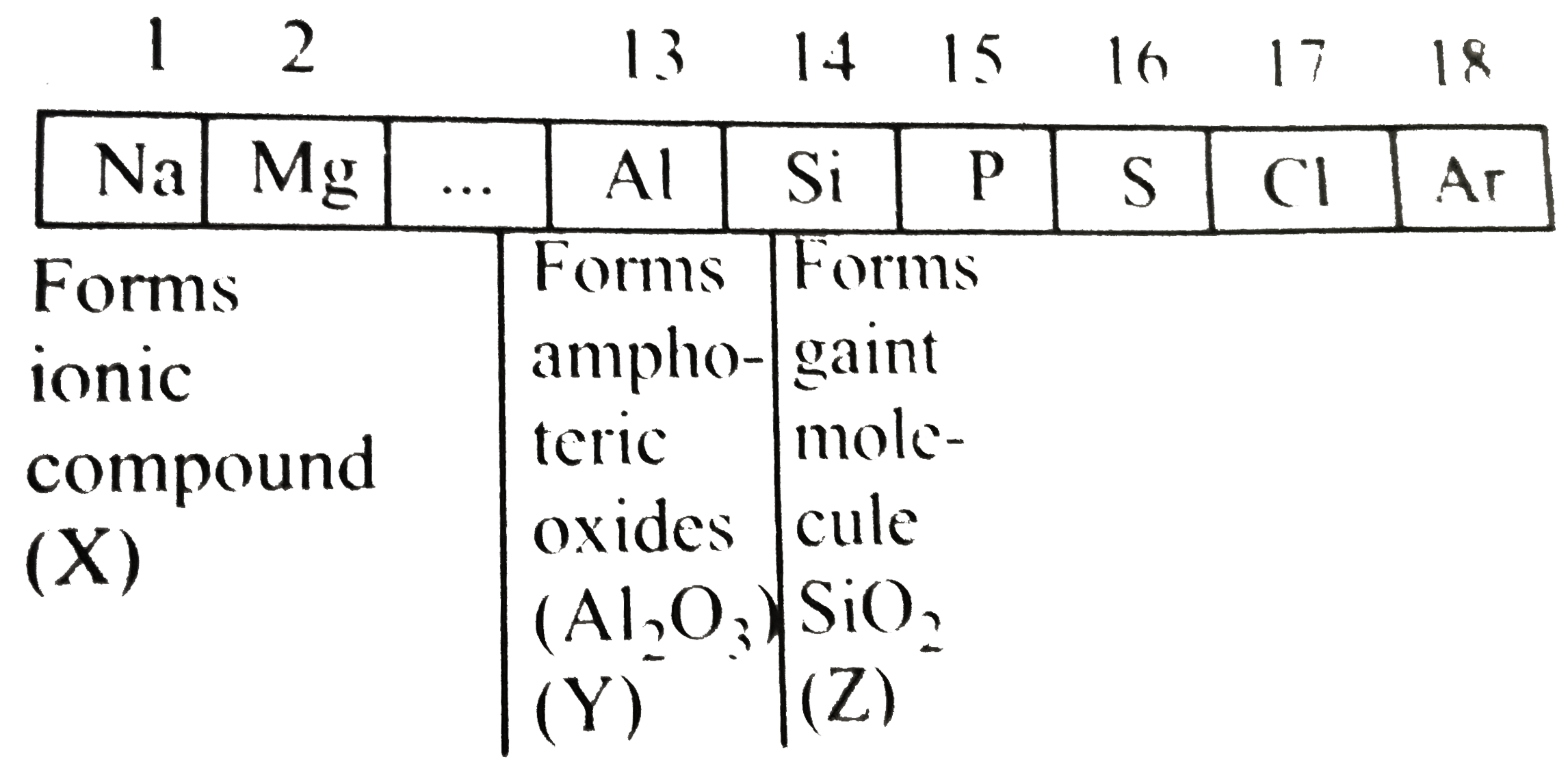(X),(Y),(Z) are elements in third short period. Oxide of (X) is ionic, (Y) is amphoteric and (Z) is a giant molecule. (X),(Y) and (Z) will have atomic number in the order :
(X)<(Y)<(Z)
(Z)<(Y)<(X)
(X)<(Z)<(Y)
(Y)<(X)<(Z)
The correct Answer is:A

Hence, the atomic number of (Z)>(Y)>(X).
Topper's Solved these Questions
- BOOK - CENGAGE CHEMISTRYCHAPTER - PERIODIC CLASSIFICATION OF ELEMENTS AND GENERAL INORGANIC CHEMISTRYEXERCISE - Ex 1.313videos
PERIODIC CLASSIFICATION OF ELEMENTS AND GENERAL INORGANIC CHEMISTRY
- BOOK - CENGAGE CHEMISTRYCHAPTER - PERIODIC CLASSIFICATION OF ELEMENTS AND GENERAL INORGANIC CHEMISTRYEXERCISE - Ex 1.3 (Objective)8videos
PERIODIC CLASSIFICATION OF ELEMENTS AND GENERAL INORGANIC CHEMISTRY
- BOOK - CENGAGE CHEMISTRYCHAPTER - PERIODIC CLASSIFICATION OF ELEMENTS AND GENERAL INORGANIC CHEMISTRYEXERCISE - Ex 1.21videos
PERIODIC CLASSIFICATION OF ELEMENTS AND GENERAL INORGANIC CHEMISTRY
- BOOK - CENGAGE CHEMISTRYCHAPTER - P-BLOCK GROUP 14 - CARBON FAMILYEXERCISE - Exercises Archives (Subjective)9videos
P-BLOCK GROUP 14 - CARBON FAMILY
- BOOK - CENGAGE CHEMISTRYCHAPTER - PURIFICATION OF ORGANIC COMPOUNDS AND QUALITATIVE AND QUANTITATIVE ANALYSISEXERCISE - Assertion Reasoning Type5videos
PURIFICATION OF ORGANIC COMPOUNDS AND QUALITATIVE AND QUANTITATIVE ANALYSIS
Similar Questions
Knowledge Check
- Question 1 - Select One
(X),(Y),(Z) are elements in third short period. Oxide of (X) is ionic, (Y) is amphoteric and (Z) is a giant molecule. (X),(Y) and (Z) will have atomic number in the order :
A(X) lt (Y) lt (Z)B(Z) lt (Y) lt (X)C(X) lt (Z) lt (Y)D(Y) lt (X) lt (Z) - Question 2 - Select One
(a),(b) and (c) are elements in the second short period. Oxide of (a) is ionic, that of (b) is amphoteric and of (c) of gaint molecule. (a),(b) and (c) have atomic number in the order-
A(a)<(b)<(c)B(c)<(b)<(a)C(a)<(c)<(b)D(b)<(a)<(c) - Question 3 - Select One
(a),(b) and (c) are elements in the second short period. Oxide of (a) is ionic, that of (b) is amphoteric and of (c) of gaint molecule. (a),(b) and (c) have atomic number in the order-
AA<B<CBC<B<ACA<C<BDB<A<C
Three elements X, Y and Z are in the 3rd periodic table. The oxides of X, Y and Z, respectively, are basic, amphoteric and acidic, The correct order of the atomic numbers of X, Y and Z is :
View SolutionThree elements, X, Y and Z belong to the same period. Their oxides are acidic, amphoteric and basic respectively. The order of electronegative of these elements in the periodic table is
View SolutionX, Y and Z are elements of the same period in the periodic table. 'X' forms an acidic oxide, 'Y' forms a basic oxide and 'Z' forms an amphoteric oxide. Which of the following represents the correct order of increasing atomic numbers?
View SolutionThe elements x,y and z are present in one period of the periodic table. Chemically their oxides are acidic, amphoteric and basic respectively. When these elements are arranged in ascending order of atomic number they are
View SolutionX, Y and Z are the three elements, each one belongs to any one of the group IA, IIIA and VA. The oxide of X is amphoteric, the oxide of Y is highly acidic, and the oxide of Z is highly basic. Identify the groups to which these elements X, Y, Z belong to?
View Solution
